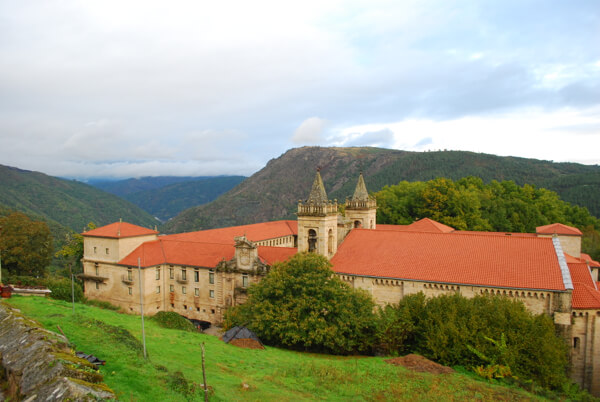The paradores of Spain are the government-run lodgings that have been incorporated (in many cases) in ancient monasteries, medieval castles and palaces. One of the most beautiful I have stayed at is in Galicia at the Parador de Santo Estevo. Located in Spain’s northwest corner aptly nicknamed “Green Spain”—because of its lush landscapes–the parador’s idyllic setting couldn’t be a more perfect portrayal.

Main entrance to Parador de Santo Estevoevo

Exploring in the Parador de Santo Estevo

The Porteria cloister at Parador de Santo Estevo.
A former Benedictine monastery, the building dates back to at least the 10th century—and the monastery’s three cloisters origins date as far back as the 6th and 7th centuries. Part of the pleasure of staying here is simply exploring these entire historic premises–with its adjacent chapel and the cloisters with their Romanesque, Gothic and Renaissance influences. I also loved sipping a late afternoon “cortado” with the Porteria cloister as a backdrop.
Within the parador, 77 rooms are set amid the cloistered areas—varying in size and shape but all featuring AC, luxurious bathrooms, and comfy beds. Internet is not available in the rooms—no doubt due to the thick stone walls—and while available in the public areas, it’s still hit or miss. Room prices start around $115, but like all the paradores there are “under 30” and “over 55” age discounts as well.
At this parador, I think it’s worth the extra effort (and cost) to make sure you have a room that overlooks a magnificent view of the canyon and forested hillside. I loved my room (small former monk cell) with its stone monk’s window seat (cushioned for 21st century comfort), and where I could rest my elbow on the sill and gaze out at the timeless vista. I couldn’t help but reflect how easy it must have been for the monks to meditate in such a peaceful space

One of the rooms at Parador de Santo Estevo
The peacefulness comes with the rural territory of course. The monastery is in the heart of what is called the Ribeira Sacra (“holy river bank”), which refers to the lands that border the meeting of the rivers Sil and Mino. To reach the parador requires quite some distance on twisty mountain roads, and it’s not uncommon for guests to get lost before finding it. Fortunately, that was not the case for me. I was with a small group that arrived in a mini van. Our problem was that the lane into the monastery is so narrow our little van had to stop atop the hill, and we had to walk down to the monastery entrance. Still, rolling my suitcase down the hill next to chestnut trees in such glorious countryside only added to the magic setting.

Chestnut trees near Parador de Santo Estevo
As always, in the paradores there is a restaurant serving up the local specialties (grilled octopus is on the menu here) but because the parador is so remote, guests should be aware it’s also probably the only option for dinner. Luckily, the fare is abundant (like the breakfast) and delicious.
The staff was helpful and friendly –offering suggestions for things to do in the area when asked. The parador has a lovely spa (which seems like a perfect accompaniment to such a tranquil retreat), although I did not have time to check it out. Hiking is popular—and there are miles of great walking trails—something I also would have enjoyed if I’d had an extra day. The area is also rich with vineyards (bodegas and wine cellars have won international awards), plus small picturesque villages, and more ancient monasteries that have a hauntingly addictive charm.
Book directly with the Parador website or compare prices on agoda.com and Booking.com.
Review and photos by Donna Tabbert Long who stayed at the Parador de Santo Estevo as a guest of the Tourist Office of Spain (Chicago).

